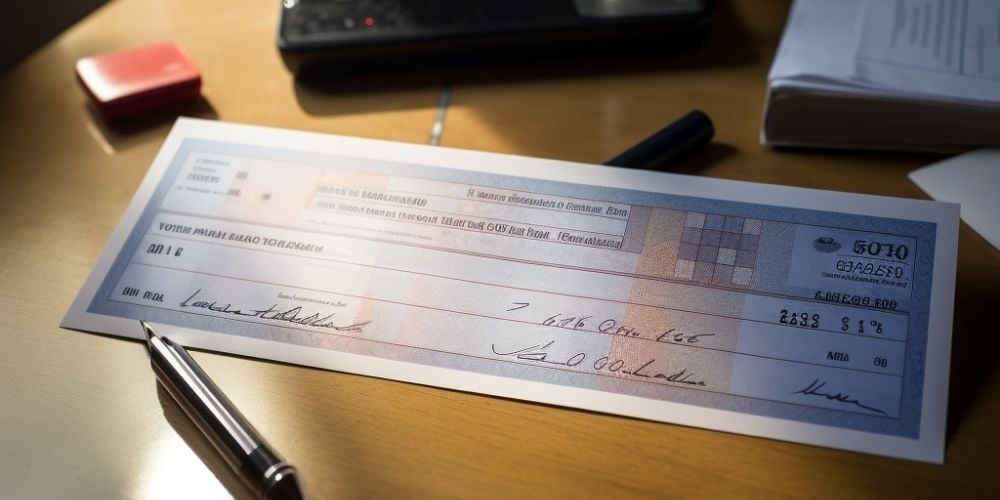Counterfeit checks pose a significant threat to real estate transactions. The consequences of unknowingly accepting or depositing a fake check can be devastating, leading to financial loss and legal troubles.
It is crucial to stay vigilant and take proactive measures to protect yourself from falling victim to counterfeit checks.
In this article, we will discuss the different types of counterfeit checks used, how to identify them, and key tips on how to avoid counterfeit checks in real estate transactions.
Types of Counterfeit Checks Commonly Used:
Counterfeiters employ various methods to create fake checks that appear legitimate.
The most commonly counterfeited checks in real estate transactions include:
Cashier’s checks:
Cashier’s checks are often targeted by counterfeiters due to the perception of their authenticity. These checks are issued by a banking institution, typically guaranteeing the funds.
However, it is important to note that even cashier’s checks can be forged.

Personal checks:
Fake personal checks are a common tool used by scammers. With advances in technology, counterfeiters can easily replicate personal checks, making them difficult to identify without close examination.
Company checks:
Fraudsters may also create counterfeit checks using a company’s name and account information. These checks appear genuine and can deceive unsuspecting individuals.
Different Check Forgery Techniques Explained
To avoid falling victim to counterfeit checks, it is important to understand the various techniques employed by fraudsters:
Physical tampering:
Scammers may alter the key details on a legitimate check, such as the payee name or the amount, using techniques like erasing ink or adding new information using a high-quality printer.
Check washing:
An increasingly common forgery technique involves washing a legitimate check by erasing the ink with chemicals, altering the details, and rewriting them to benefit the fraudster.
Digital manipulation:
Advanced technology has enabled counterfeiters to digitally create fake checks that appear authentic at first glance.
These digitally manipulated checks often feature convincing graphics and emulate genuine checks, tricking unsuspecting individuals.
How To Avoid Counterfeit Checks In Real Estate Transactions? (Tips for Identification)
To protect yourself from accepting or depositing counterfeit checks, keep the following factors in mind:
Verify the source of the check:
Always ensure that the check is from a trusted source. If it is an unfamiliar individual or company, conduct thorough research to validate their credibility. Reach out to the issuing bank directly to verify the legitimacy of the check.
Look for inconsistencies in the check:
Scrutinize the check for any discrepancies, such as misspelled words, uneven edges, or distorted logos.
Genuine checks typically have consistent print quality and a professional appearance. Be cautious if the check seems poorly printed or if the details appear blurred.
Use counterfeit detection tools:
Technology can assist in identifying counterfeit checks. Consider using tools such as ultraviolet light scanners or check verification services to verify the authenticity of the check.
These tools can reveal hidden security features or identify signs of forgery that may not be visible to the naked eye.

Tips for Avoiding Counterfeit Checks in Real Estate Transactions:
To minimize the risk of encountering counterfeit checks in real estate transactions, follow these vital tips:
Take your time:
Avoid rushing through transactions. Carefully review all documents and checks presented to you, ensuring that they meet your standards of authenticity. If anything seems suspicious or raises concerns, take the necessary steps to investigate further before proceeding.
Contact the issuing bank to verify the validity of the check:
Before accepting or depositing a large sum of money, contact the issuing bank to verify the authenticity of the check.
Provide them with the necessary details and ask for confirmation that the account has sufficient funds. The bank can inform you if any red flags are associated with the account or check in question.
Use a secure/verified payment method:
Consider using secure payment methods such as wire transfers or electronic fund transfers (EFTs) when dealing with substantial real estate transactions.
These methods provide a higher level of security compared to physical checks, reducing the risk of encountering counterfeit payments.
What to Do if You Suspect You’ve Received a Counterfeit Check:
If you suspect that you have received a counterfeit check, it is essential to take immediate action:
Contact your bank immediately:
Inform your bank about the situation and provide them with all the necessary details. They can guide you on the appropriate steps to take and help protect your accounts.
Additionally, they may liaise with the authorities or other relevant parties to investigate the incident.
Report the incident to your local law enforcement agency, providing them with all the relevant information.
This step is crucial to prevent the counterfeiters from targeting others, and for potential legal action in the future.
Cooperation with the authorities can aid in the investigation and potentially lead to the apprehension of the individuals involved in the counterfeiting operation.
Keep a record of all the details:
Maintain a thorough record of the incident, including copies of the counterfeit check, any correspondence related to the transaction, and any reports filed with the authorities.
These records may be essential for future investigations or disputes. Furthermore, documenting the incident provides a comprehensive account that can be useful for any legal proceedings that may arise.

Pro Tips:
Here are some additional pro tips to further safeguard yourself from counterfeit checks in real estate transactions:
Open communication with the other party can help establish trust and ensure both parties are aware of the risks associated with counterfeit checks. Together, you can take additional precautions to prevent fraud.
Use a trusted middleman:
Consider involving a reputable escrow service or a trusted attorney who can oversee the transaction and mitigate the risk of counterfeit checks. Their expertise and knowledge can provide an added layer of protection.
FAQs:
Q1: Are there any telltale signs that a cashier’s check is counterfeit?
A: While counterfeit cashier’s checks can be remarkably convincing, certain red flags can help identify potential fraud. Pay attention to unusual routing numbers, misspelled bank names, or discrepancies in the check amount or payee information.
Q2: Can a bank refuse to honor a counterfeit check?
A: Yes, banks have the right to refuse payment on a counterfeit check. Once discovered, the bank will notify the account holder, return the check as invalid, and provide guidance on the next steps to be taken.
Q3: Can counterfeit checks be detected using smartphone apps?
A: Some smartphone apps claim to detect counterfeit checks by analyzing the check’s security features. However, their efficacy may vary. It’s important to cautiously research and assess the reliability of such apps before using them.
Q4: How long does it take to resolve a counterfeit check case?
A: The resolution time for counterfeit check cases can vary depending on the circumstances, complexity, and involvement of law enforcement. It is advisable to remain patient and cooperate fully with authorities to bring the matter to a satisfactory conclusion.
Conclusion:
Protecting yourself from counterfeit checks in real estate transactions is of utmost importance.
By understanding the different types of counterfeit checks, learning how to identify them, and following the recommended tips, you can significantly reduce the risk of falling victim to fraudulent activities.
Stay vigilant, verify the authenticity of checks, and report any suspicious activity to ensure a safe and secure real estate transaction experience.


 Tags:
Tags:










